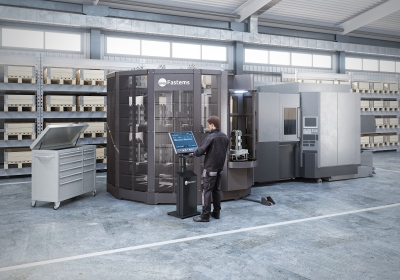
Fastems LLC has announced the launch of their Flexible Pallet Tower (FPT), the most compact pallet automation solution for a single CNC milling machine with 300 to 630 mm pallets. FPT integrates with any machine with a wide library of ready-made machine tool interfaces and multiplies the machine tool utilization up by cutting down setup times and enabling lights-out manufacturing. The plug-and-play automation system also shortens the lead times and allows for higher part mix with smaller unit costs, no matter the production batch sizes.
Compared to other similar systems in the market, Fastems FPT is compatible with any machine tool brand, and it integrates with milling machines whether or not they have automatic pallet changers. In addition, the system footprint is extremely compact: FPT-500 for 300-500mm pallets requires only 100 square feet, and FPT-1000 for 500-630mm pallets requires 175 square feet. Instead of having a fixed storage, like most of the comparable units, FPT can work with different load heights and pallet sizes with a configurable pallet storage that can store up to 24 pallets in two to four levels.
The first FPT-500 for 300-500mm pallets will be delivered to the first customer in February 2022, and the FPT-1000 for 500-630mm will launch in late spring of 2022. These solutions can be delivered within 16 weeks of order placement. The FPT completes the Fastems pallet automation offering for smaller pallets and even tightest shopfloor fitment requirements.
FPT is controlled by the completely new version of Fastems Manufacturing Management Software (MMS). MMS offers a single-view user interface with drag-and-drop production scheduling and allows bringing new workpieces into the system in under 60 seconds. The system automatically tracks and reports the key performance indicators in real time. With the plug-and-play installation and fast to learn use, FPT brings immediate automation benefits to the shop floor. Fastems CEO Mikko Nyman shared, “With this solution we can serve also the customers looking for affordable automation for smaller milling machines, both with and without the automatic pallet changers. With the compact footprint and the configurable pallet storage, FPT really fits for all kinds of manufacturers. With the new, simplified MMS user interface and the ergonomic workpiece loading station we can bring a whole new level of ergonomics to the operators.”
Contact Details
Related Glossary Terms
- computer numerical control ( CNC)
computer numerical control ( CNC)
Microprocessor-based controller dedicated to a machine tool that permits the creation or modification of parts. Programmed numerical control activates the machine’s servos and spindle drives and controls the various machining operations. See DNC, direct numerical control; NC, numerical control.
- gang cutting ( milling)
gang cutting ( milling)
Machining with several cutters mounted on a single arbor, generally for simultaneous cutting.
- milling
milling
Machining operation in which metal or other material is removed by applying power to a rotating cutter. In vertical milling, the cutting tool is mounted vertically on the spindle. In horizontal milling, the cutting tool is mounted horizontally, either directly on the spindle or on an arbor. Horizontal milling is further broken down into conventional milling, where the cutter rotates opposite the direction of feed, or “up” into the workpiece; and climb milling, where the cutter rotates in the direction of feed, or “down” into the workpiece. Milling operations include plane or surface milling, endmilling, facemilling, angle milling, form milling and profiling.
- milling machine ( mill)
milling machine ( mill)
Runs endmills and arbor-mounted milling cutters. Features include a head with a spindle that drives the cutters; a column, knee and table that provide motion in the three Cartesian axes; and a base that supports the components and houses the cutting-fluid pump and reservoir. The work is mounted on the table and fed into the rotating cutter or endmill to accomplish the milling steps; vertical milling machines also feed endmills into the work by means of a spindle-mounted quill. Models range from small manual machines to big bed-type and duplex mills. All take one of three basic forms: vertical, horizontal or convertible horizontal/vertical. Vertical machines may be knee-type (the table is mounted on a knee that can be elevated) or bed-type (the table is securely supported and only moves horizontally). In general, horizontal machines are bigger and more powerful, while vertical machines are lighter but more versatile and easier to set up and operate.








